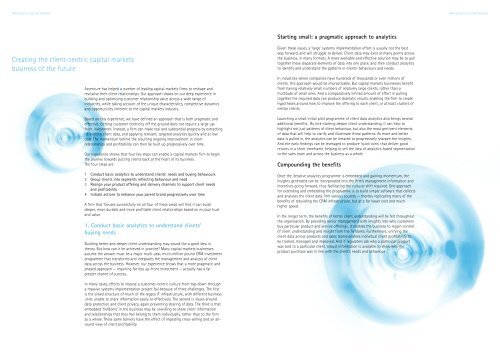Central brochure
Central brochure
Central brochure
You also want an ePaper? Increase the reach of your titles
YUMPU automatically turns print PDFs into web optimized ePapers that Google loves.
Refocusing on trust and relevance Refocusing on trust and relevance<br />
Not an option - but an imperative<br />
In Accenture’s view, refocusing on the client is not just a smart thing for capital<br />
markets businesses to do, but also a prerequisite for future high performance. Over a<br />
prolonged period of ‘fat’ years, firms neglected investment in client service in favour<br />
of developing ever more highly engineered products from within different silos. As a<br />
result, they have undermined the value and loyalty on which long-term client<br />
relationships depend, while simultaneously losing any unified or consistent view of<br />
each client’s needs, and also profitability.<br />
Today, in the colder post-crisis environment, this legacy has resulted in two major<br />
fault-lines in firms’ client relationships.<br />
• The first fault-line is a crisis of relevance and trust. The focus on developing and<br />
selling products has made clients feel that firms are pushing different products<br />
through separate parts of their organisation, with little all-round understanding<br />
of the client’s requirements. Experience shows that clients trust firms that they<br />
feel understand them and that as a result consistently provide them with relevant<br />
products that meet their needs. The widening gap between the products on offer<br />
and clients’ real needs — coupled with underperformance by some of the<br />
products themselves — has critically undermined this trust.<br />
• The second fault-line is the economic unsustainability of the product range,<br />
the business and operational complexity in involves, the sales and client service<br />
model. By effectively becoming factories churning out products through siloed,<br />
product-focused sales teams, capital markets businesses have made it very hard<br />
to create and maintain an integrated and unified all-round view not just of client<br />
need, but of client profitability. And conversely, this also means that it is very<br />
hard, if not impossible to evaluate the degree to which a significant amount of<br />
the complexity and cost in a modern capital markets business actually creates<br />
value. At the same time, reduced client willingness to buy complex, high-margin<br />
products has forced firms to refocus on some of their more commoditised<br />
offerings, driving down margins still further.<br />
The problem is compounded because, as mentioned above, capital markets businesses<br />
have allowed complexity and cost in their operations to spiral, reflecting the growing<br />
range and diversity of their activities. This complexity and cost aren’t necessarily a<br />
problem in themselves (apart from making risk, cost and capital management more<br />
difficult) provided they create value for clients that the clients are willing to pay for.<br />
However, it is questionable whether clients do value all of their providers’ complexity,<br />
and in the current configuration it is very hard for firm to distinguish value creating<br />
from value destroying complexity.<br />
Taken together, the combination of these two fault-lines with firms’ rising complexity<br />
and cost means leaving things as they are is not an option. Post-crisis, it is<br />
increasingly clear that what key segments of a capital markets firm’s client base now<br />
value — and will pay for — is not products for products’ sake. Instead, they want a<br />
service that is aligned to and serves their specific business needs for an acceptable<br />
price. Delivering this in a world of tighter margins and higher capital requirements is<br />
the challenge now facing capital markets businesses worldwide.<br />
The way forward: client centricity<br />
There is a proven way by which firms can simultaneously address both the crisis of<br />
relevance, and the economic unsustainability of their product and sales model. By<br />
putting the client’s behaviours and needs at the heart of everything they do, and<br />
aligning every aspect of their service and product offering with these, firms can<br />
rebuild relevance and trust and regain visibility and control over client profitability.<br />
Once client centricity is embedded, the sales and marketing teams can increase the<br />
benefits still further, by using the new client insight to identify and target highpotential<br />
clients with the optimal combination of product, service and channel.<br />
Equally importantly, the firm will have clear sight of the return on investment from<br />
these efforts.<br />
In seeking to achieve customer centricity, capital markets businesses need to take<br />
into account two ongoing shifts on the client side. One is that today’s clients are<br />
more diverse than ever before, with more specialised needs and preferences — so<br />
understanding them requires correspondingly more insight and precision. The other is<br />
that customer expectations are rising as fast as their sense of sense of loyalty<br />
declines, with the result that satisfying clients’ requirements now demands more<br />
focus and consistency than in the past.<br />
So, how can capital markets businesses achieve the benefits of client centricity in a<br />
way that takes account of these challenges?

















